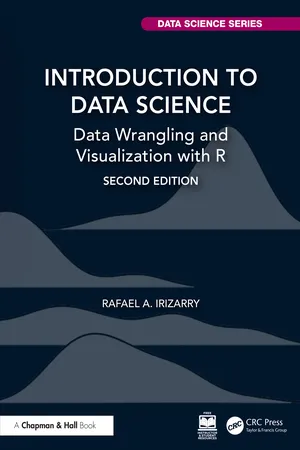
- 376 pages
- English
- ePUB (mobile friendly)
- Only available on web
About This Book
Unlike the first edition, the new edition has been split into two books.
Thoroughly revised and updated, this is the first book of the second edition of Introduction to Data Science: Data Wrangling and Visualization with R. It introduces skills that can help you tackle real-world data analysis challenges. These include R programming, data wrangling with dplyr, data visualization with ggplot2, file organization with UNIX/Linux shell, version control with Git and GitHub, and reproducible document preparation with Quarto and knitr. The new edition includes additional material/chapters on data.table, locales, and accessing data through APIs. The book is divided into four parts: R, Data Visualization, Data Wrangling, and Productivity Tools. Each part has several chapters meant to be presented as one lecture and includes dozens of exercises. The second book will cover topics including probability, statistics and prediction algorithms with R.
Throughout the book, we use motivating case studies. In each case study, we try to realistically mimic a data scientist's experience. For each of the skills covered, we start by asking specific questions and answer these through data analysis. Examples of the case studies included in the book are: US murder rates by state, self-reported student heights, trends in world health and economics, and the impact of vaccines on infectious disease rates.
This book is meant to be a textbook for a first course in Data Science. No previous knowledge of R is necessary, although some experience with programming may be helpful. To be a successful data analyst implementing these skills covered in this book requires understanding advanced statistical concepts, such as those covered the second book. If you read and understand all the chapters and complete all the exercises in this book, and understand statistical concepts, you will be well-positioned to perform basic data analysis tasks and you will be prepared to learn the more advanced concepts and skills needed to become an expert.
Frequently asked questions
Information
Table of contents
- Cover Page
- Half-Title Page
- Series Page
- Title Page
- Copyright Page
- Table of contents
- Preface
- Acknowledgments
- Introduction
- I R
- II Data Visualization
- III Data Wrangling
- IV Productivity Tools
- Index